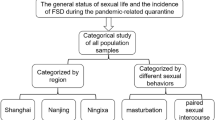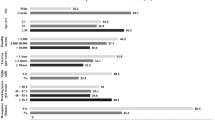Abstract
Female sexual dysfunction (FSD) is defined as disturbances in sexual desire and the psychophysiological changes that characterize the sexual response cycle, which cause marked distress and interpersonal difficulty. Female sexual dysfunction is strongly related to socio-cultural characteristics of a certain region and can change over time. Authors previously reported the features of FSD in Korea through an analysis of an internet-based survey conducted in 2004. This time, we designed a 10-year interval study to compare the prevalence of and risk factors of FSD through the Korean Internet Sexuality Survey (KISS) 2014. The internet-based survey was targeted towards 20−59-year-old women, who were asked to answer the questionnaire only if they were sexually active. In total, 516 responses were analyzed and the mean age of the subjects was 38.1±10.3 years. We defined FSD as having a total FSFI score of under 25.0, and resulted in a prevalence of FSD of 46.7%. The prevalence of FSD in each age group increased with age from 23.7, 45.4, 51.4 to 72%, for those in their 20, 30, 40 and 50s, respectively. Among the 50s age group, lubrication and pain domain dysfunctions were highly prevalent. The risk factors for FSD were identified as constipation, depression, incontinence, age of first intercourse, number of sexual partners and the use of oral contraceptive pills. Although the some demographic features of this study was different with those of the 2004 repot, the prevalence of FSD was similar with that reported previously in 2004 and a few risk factors of FSD was consistently significant in these interval studies.
This is a preview of subscription content, access via your institution
Access options
Subscribe to this journal
Receive 8 print issues and online access
$259.00 per year
only $32.38 per issue
Buy this article
- Purchase on Springer Link
- Instant access to full article PDF
Prices may be subject to local taxes which are calculated during checkout

Similar content being viewed by others
References
American Psychiatric Association.Diagnostic and Statistical Manual of Mental Disorders (DSM-5). American Psychiatric Association: Washington, DC, 2013.
Stephenson KR, Meston CM . Why is impaired sexual function distressing to women? the primacy of pleasure in female sexual dysfunction. J Sex Med 2015; 12: 728–737.
American Psychiatric Association.Diagnostic and Statistical Manual of Mental Disorders,4th edn (DSM-IV-TR). American Psychiatric Association: Washington, DC, 2000.
Burri A, Spector T . Recent and lifelong sexual dysfunction in a female UK population sample: prevalence and risk factors. J Sex Med 2011; 8: 2420–2430.
Mohammad Abdollahi MT, Raisi F, Saffari E . The prevalence of female sexual dysfunction among migraine patients. Iran J Neurol 2015; 14: 8–11.
Laumann EO, Paik A, Rosen RC . Sexual dysfunction in the United States: prevalence and predictors. JAMA 1999; 281: 537–544.
Song SH, Jeon H, Kim SW, Paick JS, Son H . The prevalence and risk factors of female sexual dysfunction in young korean women: an internet-based survey. J Sex Med 2008; 5: 1694–1701.
Ma J, Pan L, Lei Y, Zhang A, Kan Y . Prevalence of female sexual dysfunction in urban chinese women based on cutoff scores of the Chinese version of the female sexual function index: a preliminary study. J Sex Med 2014; 11: 909–919.
Echeverry MC, Arango A, Castro B, Raigosa G . Study of the prevalence of female sexual dysfunction in sexually active women 18 to 40 years of age in Medellin, Colombia. J Sex Med 2010; 7: 2663–2669.
Jaafarpour M, Khani A, Khajavikhan J, Suhrabi Z . Female sexual dysfunction: prevalence and risk factors. J Clin Diagn Res 2013; 7: 2877–2880.
Safarinejad MR . Female sexual dysfunction in a population-based study in Iran: prevalence and associated risk factors. Int J Impot Res 2006; 18: 382–395.
Ishak IH, Low WY, Othman S . Prevalence, risk factors, and predictors of female sexual dysfunction in a primary care setting: a survey finding. J Sex Med 2010; 7: 3080–3087.
Ibrahim ZM, Ahmed MR, Sayed Ahmed WA . Prevalence and risk factors for female sexual dysfunction among Egyptian women. Arch Gynecol Obstet 2013; 287: 1173–1180.
Son H, Song SH, Lee JY, Paick JS . Relationship between premature ejaculation and depression in Korean males. J Sex Med 2011; 8: 2062–2070.
Choi WS, Song SH, Son H . Epidemiological study of complementary and alternative medicine (CAM) use for the improvement of sexual function in young Korean men: the Korean Internet Sexuality Survey (KISS), part II. J Sex Med 2012; 9: 2238–2247.
Son H, Song SH, Kim SW, Paick JS . Self-reported premature ejaculation prevalence and characteristics in Korean young males: community-based data from an internet survey. J Androl 2010; 31: 540–546.
Kim HY SH, Park KS, Jeong SJ, Lee JY, Ryu SB . Development of the Korean-version of Female Sexual Function Index (FSFI). Korean J Androl 2002; 20: 50–56.
Jeong SJ, Homma Y, Oh SJ . Korean version of the overactive bladder symptom score questionnaire: translation and linguistic validation. Int Neurourol J 2011; 15: 135–142.
Hyung-Mo S, Jung-Bum K, Young-Nam P, Dai-Seok B, Sun-Hee L, Hyun-Nie A . A Study on the reliability and the validity of Korean version of the Beck Depression Inventory-II(BDI -II). J Korean Soc Biol Ther Psychiatry 2008; 14: 201–212.
Azadzoi KM, Siroky MB . Neurologic factors in female sexual function and dysfunction. Korean J Urol 2010; 51: 443–449.
Elsamra S, Nazmy M, Shin D, Fisch H, Sawczuk I, Fromer D . Female sexual dysfunction in urological patients: findings from a major metropolitan area in the USA. BJU Int 2010; 106: 524–526.
Bond DS, Vithiananthan S, Leahey TM, Thomas JG, Sax HC, Pohl D et al. Prevalence and degree of sexual dysfunction in a sample of women seeking bariatric surgery. Surg Obes Relat Dis 2009; 5: 698–704.
Wiegel M, Meston C, Rosen R . The female sexual function index (FSFI): cross-validation and development of clinical cutoff scores. J Sex Marital Ther 2005; 31: 1–20.
Shaeer O, Shaeer K, Shaeer E . The Global Online Sexuality Survey (GOSS): female sexual dysfunction among Internet users in the reproductive age group in the Middle East. J Sex Med 2012; 9: 411–424.
Shabsigh R, Anastasiades A, Cooper KL, Rutman MP . Female sexual dysfunction, voiding symptoms and depression: common findings in partners of men with erectile dysfunction. World J Urol 2006; 24: 653–656.
Tutoglu A, Boyaci A, Koca I, Celen E, Korkmaz N . Quality of life, depression, and sexual dysfunction in spouses of female patients with fibromyalgia. Rheumatol Int 2014; 34: 1079–1084.
Nascimento ER, Maia AC, Nardi AE, Silva AC . Sexual dysfunction in arterial hypertension women: the role of depression and anxiety. J Affect Disord 2015; 181: 96–100.
Pace G, Silvestri V, Guala L, Vicentini C . Body mass index, urinary incontinence, and female sexual dysfunction: how they affect female postmenopausal health. Menopause 2009; 16: 1188–1192.
Cohen BL, Barboglio P, Gousse A . The impact of lower urinary tract symptoms and urinary incontinence on female sexual dysfunction using a validated instrument. J Sex Med 2008; 5: 1418–1423.
Brotto LA . Improving the Female Sexual Function Index. [Letter]. J Sex Marital Ther 2009; 35: 83–85.
Author information
Authors and Affiliations
Corresponding author
Ethics declarations
Competing interests
The authors declare no conflict of interest.
Rights and permissions
About this article
Cite this article
Shin, H., Min, B., Park, J. et al. A 10-year interval study to compare the prevalence and risk factors of female sexual dysfunction in Korea: the Korean internet sexuality survey (KISS) 2014. Int J Impot Res 29, 49–53 (2017). https://doi.org/10.1038/ijir.2016.41
Received:
Revised:
Accepted:
Published:
Issue Date:
DOI: https://doi.org/10.1038/ijir.2016.41



